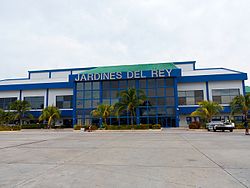Jardines del Rey Airport
|
Jardines del Rey Airport Aeropuerto de Jardines del Rey |
|||||||||||
|---|---|---|---|---|---|---|---|---|---|---|---|
 |
|||||||||||
| Summary | |||||||||||
| Airport type | Public | ||||||||||
| Operator | Aena and ECASA | ||||||||||
| Location | Cayo Coco, Ciego de Ávila Province, Cuba | ||||||||||
| Elevation AMSL | 4 m / 13 ft | ||||||||||
| Coordinates | 22°27′40″N 078°19′43″W / 22.46111°N 78.32861°WCoordinates: 22°27′40″N 078°19′43″W / 22.46111°N 78.32861°W | ||||||||||
| Map | |||||||||||
| Location in Cuba | |||||||||||
| Runways | |||||||||||
|
|||||||||||
Jardines del Rey Airport (Spanish: Aeropuerto de Jardines del Rey) (IATA: CCC, ICAO: MUCC) is an airport situated on the island of Cayo Coco, part of the Cuban province of Ciego de Ávila. It takes its name from the Jardines del Rey archipelago, which includes Cayo Coco. Inaugurated in December 2002, the airport was built to better serve tourists to the island, who previously had to arrive at Máximo Gómez Airport about 70 kilometres (43 mi) to the south. Jardines del Rey Airport is the only airport in Cuba managed in part by a foreign company; Aena and ECASA jointly operate the airport. It receives well over 200,000 passengers per year, most of whom are foreign tourists.
In the early 1990s, the Cuban government began to develop the tourism sector in Cayo Coco, and several resorts were constructed. To reach Cayo Coco, tourists had to fly to Máximo Gómez Airport on the mainland and then take a one-hour bus ride to the island. In order to make travel to Cayo Coco more convenient, the Cuban government announced in 1999 that it would build a new airport on the island itself. Environmentalists disapproved of the site selected for the airport, but the government responded that the site was located in a zone already designated for infrastructure development. Meanwhile, the existing Cayo Coco Airport on the island, situated in a more environmentally sensitive area, would be demolished and reforested.
Construction of the airport commenced in January 2000. Later in the year, Spanish airports company Aena signed a contract with the Cuban government to build and operate the new airport, thus becoming the first foreign entity to manage a Cuban airport. Management is shared with the Cuban company ECASA. The first phase of the project was completed in early 2002, which encompassed the construction of the runway, taxiways, apron, air traffic control tower and a temporary terminal with a capacity for 150 passengers. The airport was officially inaugurated on 26 December 2002 upon the completion of a larger terminal, which brought the airport's annual capacity to 1.2 million passengers.
...
Wikipedia

